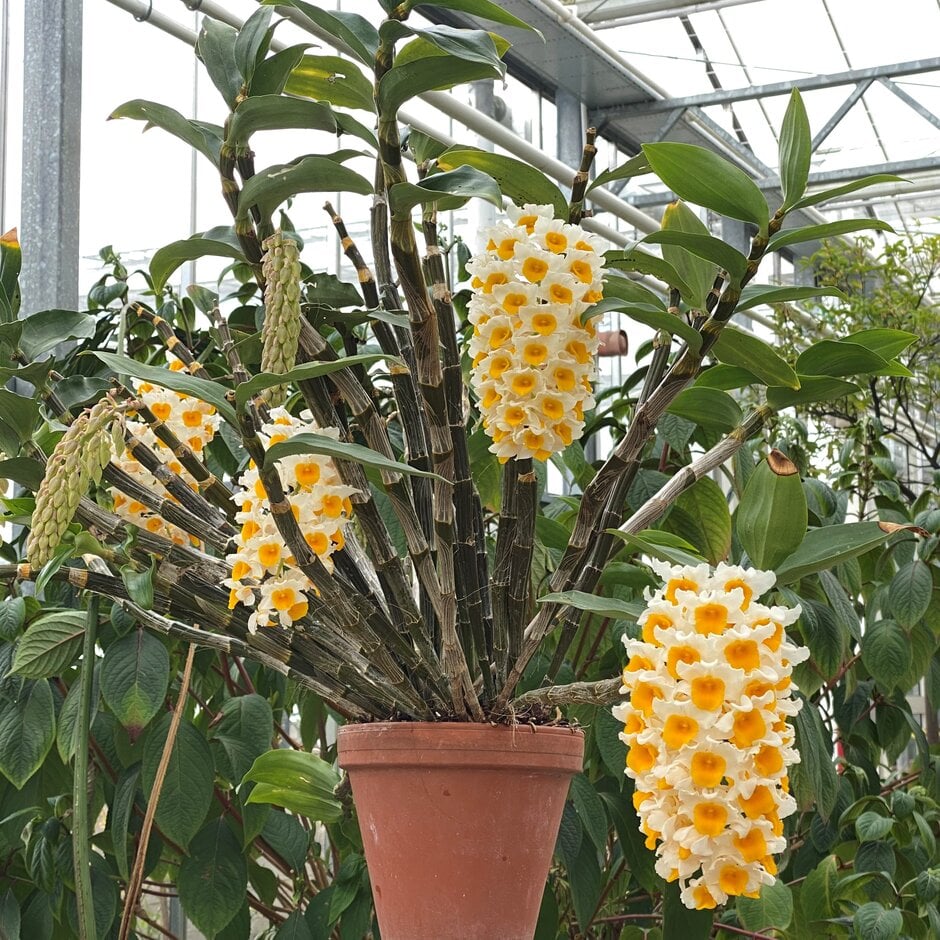Dendrobium thyrsiflorum
pinecone-like raceme dendrobium
An epiphytic, medium-sized orchid with long, cane-like stems (pseudobulbs). Five to seven dark green, lance-shaped, leathery leaves are alternately arranged on the upper half or near the top of each pseudobulb. Each leaf is up to 15cm long and 3-4cm wide. Pendant flowering stems emerge from the axils of leaves on mature canes and bear up to 30, densely arranged flowers. Each flower is 3- 5cm large, white with dark yellow lip. The lip is round, with frilled edge. Petals and sepals are usually white, sometimes pale pink.
Size
Ultimate height
0.5–1 metresTime to ultimate height
5–10 yearsUltimate spread
0.5–1 metresGrowing conditions
Moisture
Well–drainedpH
NeutralColour & scent
| Stem | Flower | Foliage | Fruit | |
| Spring | White Yellow | Green | ||
|---|---|---|---|---|
| Summer | White Yellow | Green | ||
| Autumn | Green | |||
| Winter | Green |
Position
- Full sun
- Partial shade
Aspect
East–facing or North–facing or South–facing or West–facing
Exposure
Sheltered Hardiness
H1BBotanical details
- Family
- Orchidaceae
- Native to GB / Ireland
- No
- Foliage
- Evergreen or Semi evergreen
- Habit
- Clump forming, Columnar upright, Pendulous weeping
- Genus
Dendrobium are epiphytic and terrestrial orchids with elongated, stem-like pseudobulbs bearing linear to ovate leaves. Racemes or panicles of showy flowers are produced from nodes along the stems mainly in spring
- Name status
Correct
- Plant range
- S Asia
How to grow
Cultivation
Grow in an epiphytic, medium grade, bark-based potting mix with added perlite, moss, or coir. As with many orchids, they grow best when the roots are slightly restricted. Therefore, avoid over-potting or frequent root disturbance. Provide bright light conditions throughout the year. The average temperatures are 25-30°C during day and 16-20°C at night time. Plant requires frequent watering and relatively high humidity during spring and summer months and a slightly drier and cooler conditions in winter - reduce watering and feeding in October, but do not leave plant dry for long period of time. See indoor orchid cultivation
Propagation
Propagation by seed is only possible in controlled laboratory environment. Mature plants may be divided when the plant overgrows the pot. Sideshoots (keiki) may develop on older canes - remove and pot them into sphagnum moss when the new roots are at least 2cm long.
Suggested planting locations and garden types
- Houseplants
- Conservatory and greenhouse
Pruning
No pruning required. Remove spent flowers as necessary, but do not cut the whole cane unless completely shrivelled. Oldest canes may be removed as long as there are enough, younger, thick, leaf-bearing canes on the plant.
Pests
May be susceptible to scale insects, aphids, mealybugs and red spider mite.
Diseases
Generally disease-free.
Get involved
The Royal Horticultural Society is the UK’s leading gardening charity. We aim to enrich everyone’s life through plants, and make the UK a greener and more beautiful place.

